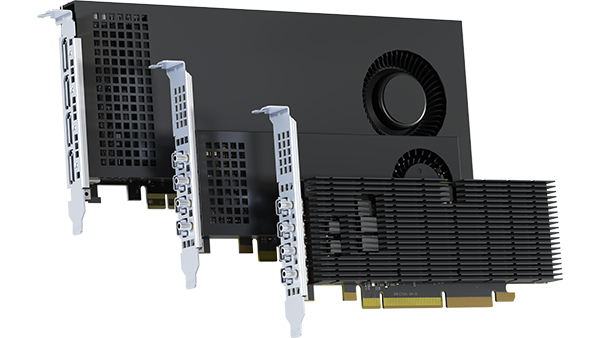Matrox Adopts Intel Alchemist GPUs for New Luma Graphics Cards
by Anton Shilov on April 28, 2023 6:00 PM EST
While they've long since given up developing GPUs, Matrox has remained a notable player in the video card industry for over four decades. These days, the company has settled into a modest role of providing graphics cards based on other vendors' GPUs for use in niche or boutique use cases, where Matrox can differentiate based on their software and support. And while their sales volume as a whole is limited, there's a certain degree of validation that comes from Matrox tapping a vendor's GPUs for their latest video cards.
To that end, Intel this week has finally earned their tip of the hat from the oldest of the video card vendors, with the announcement of a new series of multi-monitor display cards built around Intel's Alchemist architecture GPUs. Matrox's new Luma series graphics cards are based on Intel's Arc A310 and A380 graphics hardware, with the niche video card maker looking to tap into the Alchemist's class-leading video decoding and encoding capabilities, as well as the display output features and flexibility that are critical for a multi-display card.
Matrox Video's Luma family of graphics boards includes three products: the full-sized single-slot Luma A380 based on the Arc A380 (ACM-G11 with 1024 stream processors) with 6GB of memory; the low-profile single-slot fanless Luma A310 based on the Arc A310 (ACM-G11 with 768 stream processors) with 4GB of memory; and the low-profile single-slot Luma A310F that is equipped with a active cooling system.
All three Matrox Luma graphics cards have four DisplayPort 2.1 UHBR10 (40Gbps) outputs and thus can drive four 4Kp144/5Kp60 monitors (uncompressed, 4:4:4) or two 8Kp60 or 5Kp120 displays using two of such ports for each displays. As for features, they offer the same capabilities as other Intel Arc A310/A380-based offerings, including support for DirectX 12 Ultimate, OpenGL 4.6, Vulkan 1.3, and OpenCL 3.0 APIs, as well as encoding and decoding of H.264, H.265, VP9, and AV1 video streams. As an added bonus, they retain support for Intel's oneAPI for compute tasks, as well as the Intel Distribution of OpenVINO toolkit for AI development.
All of the Luma graphics cards consume no more than 75W and can be powered entirely via a PCIe slot without any auxiliary power connectors, and the A310-based offerings are intended to fit into the most compact PCs that are out there. Furthermore, their single-slot design means that upwards of several cards can be installed into a single desktop PC for systems that need to drive eight, 12, or more monitors.
Meanwhile, it's interesting to note that while Matrox has not announced the discontinuation of their previous generation cards for these product segments – the NVIDIA based D-series and AMD-based M-series – in terms of specifications these new Intel cards should supplant the older cards in every way. Intel's DisplayPort 2.1 capabilities are likely the driving factor given Matrox's intended niche, with NVIDIA in particular being boxed out by not including DisplayPort 2.1 functionality with their Ada Lovelace generation GPU architecture.
Matrox Video's Luma boards are aimed primarily at the medical, digital signage, control room, video wall, and industrial markets. The cards come with a base three-year warranty, which can be further extended and a guaranteed lifecycle of seven years, which is important for some of the markets that they are intended for.
Other advantages Matrox's Luma board offer include support for Matrox's PowerDesk software developed to handle exotic multi-display configurations.
Matrox did not announce prices of the boards, though given their orientation on commercial, professional, and industrial applications, they will be priced accordingly.
Source: Matrox (via SH SOTN)










26 Comments
View All Comments
Threska - Saturday, April 29, 2023 - link
Multi-monitor setups on the wall street trading floor for example. Most modern GPUs give you about four outputs.Findecanor - Saturday, April 29, 2023 - link
I have also seen Matrox in the broadcasting industry, as they have supported professional video formats and connectors.MadAd - Saturday, April 29, 2023 - link
I remember complaining about having to buy a Matrox G100 on top of two Voodoo2 to replace a single Voodoo Rush which never worked properly with new 3D games (primarily Unreal with its reflective surfaces and online deathmatch mode). Ended up never having a problem with it and sold it years later in a PC I built from parts.dubyadubya - Tuesday, May 2, 2023 - link
I ran two Voodoo two's in SLI with a Tseng Labs ET6000 dos accelerator as any gamer of the day would not give up on Duke 3D and the like. A Sound Blaster AWE32 was also a must have.meacupla - Saturday, April 29, 2023 - link
Matrox, the SEGA of graphics cards industry.Samus - Tuesday, May 2, 2023 - link
I laughed at this but hey at least Matrox has remained profitable.PeachNCream - Saturday, April 29, 2023 - link
Single slot, no power connectors required, and even a low profile fanless SKU. Its a pity that there are niche instead of mainstream graphics adapters.MadAd - Saturday, April 29, 2023 - link
Theres nothing stopping team red or green developing the 2d portion of their cards to as high as standard, just not many gamers would need it or pay for it if the costs were added on. Its a niche product for a reason, not many workstations need multihead full bandwidth 4k - 8k arrays just yet.Threska - Saturday, April 29, 2023 - link
2D implemented using 3D.https://gamedev.net/forums/topic/613700-2d-acceler...
https://www.tomshardware.com/reviews/2d-windows-gd...
PeachNCream - Sunday, April 30, 2023 - link
Did you reply to the wrong person? I didn't mention anything about 2D or 3D so I'm not sure what point it is that you're attempting to articulate.